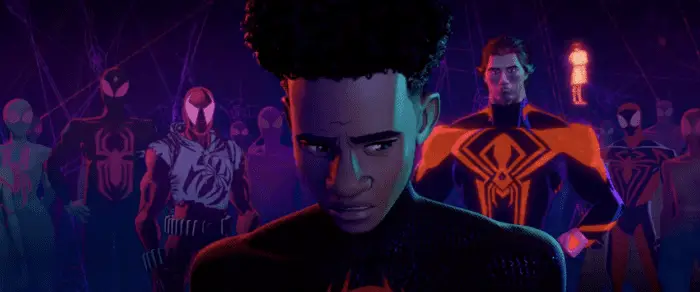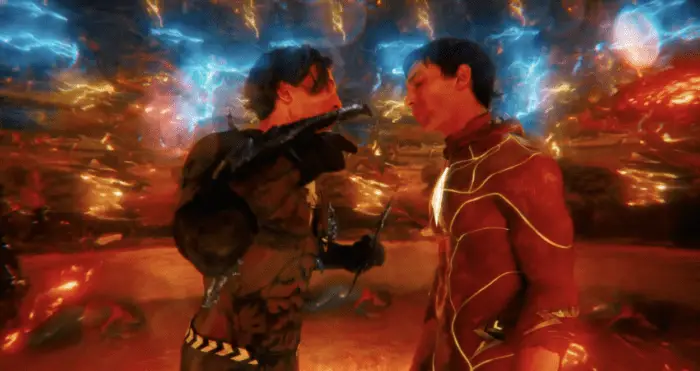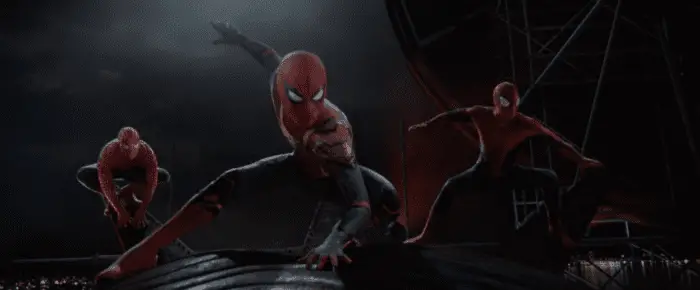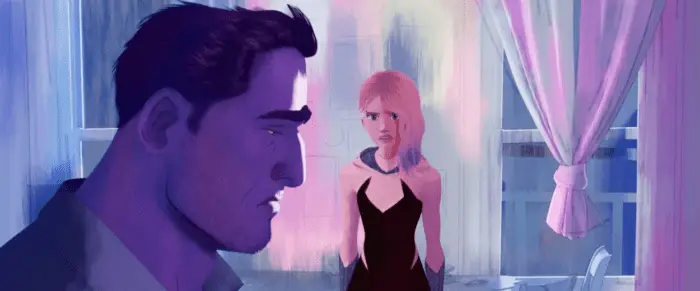Note: This article contains spoilers for Spider-Man: Across the Spider-Verse, The Flash, and Spider-Man: No Way Home. For Film Obsessive’s spoiler-free review of Across the Spider-Verse, click here, and for a spoiler-free review of The Flash, click here.
A little over halfway through Spider-Man: Across the Spider-Verse, our protagonist, Miles Morales (Shameik Moore), comes face-to-face with a key component holding the multi-versal fabric of reality together: canon events. He’s just saved Police Inspector Singh — the father of Gayatri, the love interest of Spider-Man India, Pavitr Prabhakar (Karan Soni) — and watched erstwhile villain-of-the-week Spot (Jason Schwartzmann) transform into an eldritch abomination, all without much immediate consequence. Moments afterwards, however, he’s lectured to by Miguel O’Hara (Oscar Isaac), also known as Spider-Man 2099, on how exactly the Spider-Verse is supposed to function. For every Spider-Man intertwined in the multiverse, there are quintessential “canon events” each of them must go through to define their identity as Spider-Man. They need to have been bitten by a radioactive spider; they need to have lost their uncle; they need to have learned that with great power comes great responsibility; they need to have met some kind of a Mary Jane or Gwen Stacy; etc.
Among one of these events, as Miguel outlines, is ASM-90: a police captain close to Spider-Man needs to have died after attempting to save a child from falling rubble. But a rupture has been formed in Pavitr’s canon—ASM-90 never happened, because Miles stopped it from occurring by saving Inspector Singh. The consequence, as Miguel notes, is the destabilization of Pavitr’s universe from a quantum hole, which, if not properly stopped, could lead to the potential destruction of the Spider-Verse as they know it.
Such destruction is also intimately familiar to Miguel, by his account. He indirectly caused the dissolution of a universe in which he replaced a version of himself that was killed, and was supposed to stay dead. To top it all off, Miles’s father, Jefferson (Brian Tyree Henry), is about to be sworn in as police captain in two days, and Spot is about to cause ASM-90 in Miles’s universe by vengefully annihilating everyone he loves. Unfortunately for Miles, Miguel is not about to let another canon event be stopped again. In his own words, spoken with the weight of terrible personal experience: “Being Spider-Man is a sacrifice.”
And yet, faced with such pivotal knowledge about the fate of his family, Miles takes a leap of faith. Pursued by the entire Spider-Society, he rushes off to save his father and defy the canon.

Meanwhile, in the climax of The Flash, our protagonist, Barry Allen (Ezra Miller), finds himself standing next to a 2013 rendition of himself at the center of the Chronobowl. In other words, he’s in an infinitely recursive, colosseum-like zone within the Speed Force, the source of his powers, that allows him to travel back in time to individual moments. With each ascending “row” of this zone is a moment in time that Barry can access, and the further and higher away a moment is, the further back in time he has to venture.
Towards the beginning of the film, Barry disturbed a canon event of his own; the murder of his mother, Nora (Maribel Verdú), an incident that also led to the wrongful imprisonment of his father, Henry (Ron Livingston), who was off running errands at the time. By saving Nora and freeing Henry, Barry accidentally created a broken universe inhabited by his aforementioned and more naïve 2013 self, in which the Justice League as Barry knows it cannot be assembled. In this universe, Superman, originally Kal-El, is instead a Kryptonian woman named Kara Zor-El (Sasha Calle). Bruce Wayne (Michael Keaton), meanwhile, is instead an older, retired man who has left his Batcave and extensive armory of Batman gear to collect dust.
One detail that hasn’t changed about this universe? Much like the events of Man of Steel, General Zod (Michael Shannon) is arriving to Earth to terraform it into a new Krypton. With the combined forces of two Flashes, Supergirl, and Batman, our heroes attempt to do everything in their power to prevent the attack from continuing, but no matter how hard they try, it never seems to be enough. In every possible rendition of their final battle, Supergirl is killed by Zod, and Batman dies trying to deter the invasion. Desperate to find a means of avoiding such seemingly needless sacrifice, 2013-Barry enters and exits the Speed Force again and again to alter the course of events, but never comes to grips with the truth that Barry slowly but surely realizes. There is no changing their deaths, and the multiverse is about to collapse under the weight of their attempts to alter the past.
Faced with such pivotal knowledge about the fate of the multiverse, Barry grieves the action he must take. He chooses to let his mother die and preserve the canon.

Yes, the narrative methods through which these films come to their individual conclusions are certainly different. For one, Miles’s decision in Across the Spider-Verse is in defiance of an algorithmic projection of what his future will be, or rather, how it should be—Barry’s decision in The Flash is made in the wake of an already-decaying multiverse brought on by ever-looping time travel shenanigans. But the diametric opposition of their thematic cores, the parental commonalities between them, and the proximity in release date between these two films (Spider-Man: Across the Spider-Verse released on June 2, 2023, and The Flash released only ten days afterwards) makes their parallels only that much more irresistible, and speak greatly to the means through which these heroes have been defined across iterations. The Flash submits to the consistency of multi-versal trauma, implying said trauma to be a necessity for defining one’s own heroism. Across the Spider-Verse gazes straight through the ethical immorality of that necessity, resisting such a deeply troubling implication and the complicity it requires at nearly every turn possible.
The angle that The Flash takes is largely one of acquiescence and inevitability, with its primary argument being that without the sacrifices these heroes endure, they would never have been those heroes in the first place. Such a passive viewpoint is rather bluntly outlined in a major speech that Barry’s original universe Bruce Wayne (Ben Affleck) delivers towards the beginning of the film, as Barry eagerly explains to Bruce the possibilities that have just been opened up to him now that he knows a way to travel through time with his powers.
In his brief spiel, Bruce reiterates his own canon event that shaped who he is as Batman: the death of his parents. For almost every iteration that we’ve seen of Batman, the murder of Thomas and Martha Wayne is the developmental trauma of Bruce’s life that motivates his entire philosophy of heroism. His ethos of taking down villains who operate on selfishness and corruption, as well as his methods, such as his refusal to kill or use firearms, all stem from this one moment of unfathomable loss. In his words, those deaths made him who he is, and there is no Batman without the death of Thomas and Martha Wayne.

As a result, we see The Flash continually punish its characters for deviating from moments that are almost designed to be preordained. For one, the most immediate consequence that hits Barry following his attempt to save his mother is the loss of his Speed Force powers, in exchange for his alternate 2013 self receiving them. Later, returning to the climax of the film, the result of 2013-Barry’s attempts to save Supergirl and Keaton’s Batman from dying in the battle is his grotesque, aged transformation into a Dark Flash. Covered all over in shards of Kryptonite and dark material, he’s spent decades trying to alter events whose course can never be changed, regardless of how they eventually manifest. And even at the very end of the film, when the multi-versal calamity has been resolved after Barry lets his mother die, a small alteration that Barry makes in order to clear his father’s name leads to Bruce morphing into yet another version of himself, played this time by Batman and Robin‘s very own George Clooney.
The enforcement of such “canonical” tropes– which all seem to exist regardless of what version of a given superhero we’re watching on screen– have been endemic in discourse surrounding the seeming “correctness” of different versions of superheroes we see in media, as well as other superhero-multiverse films that have emerged. A relevant example: for every live-action iteration of Spider-Man we’ve seen so far, even small differences in execution between “canon events” have all invited some form of comparative discussion between them. Perhaps the criticism more generally directed towards Andrew Garfield’s Spider-Man could be the most demonstrative of this disparity in action. For instance, many have found issue with his Peter Parker’s initially vengeful motivations directed at his uncle’s killer after donning the Spider-Man mask, in contrast to his counterparts’ more vigilante-oriented leanings—even as he learns to grow out of them into something more honorable.
Regardless, however, the most pivotal canon events in question have largely stayed the same between them. Tom Holland, Andrew Garfield, and Tobey Maguire’s renditions of Spider-Man were all bitten by radioactive spiders; they were all told that with great power comes great responsibility; they have all met either a Mary Jane (MJ) or a Gwen Stacy; and they have all lost either an uncle or an aunt. Andrew Garfield’s Spider-Man suffers even further, having lost both Gwen Stacy and her father, who was a police captain. And it’s primarily through their grief and loss that all three Spider-Men bond and fight together in the Marvel Cinematic Universe’s own Spider-Man: No Way Home, a film that makes narrative use of these common losses as a binding force that defines their collective heroism.

What is the argument that emerges, then, in regards to how we view trauma within our own lives? If the argument of films like The Flash and No Way Home is that the creation of heroism and a sense of community is built off the backs of unfathomable grief, loss, and trauma. Does that warrant us then forcing ourselves to be dragged through that trauma as a result to come out the other side heroic? We throw around and glorify adages like “what doesn’t kill you makes you stronger” or “the days that break you are the days that make you,” but would we lose any of our heroism, our strength, and anything else positive about ourselves by not allowing any of the days that break us to happen in the first place? And does the world around us become any less stable because we no longer want loss and trauma to inflict irrecoverable damage on our lives?
Evidence abounds in Spider-Man: Across the Spider-Verse that no, in fact, the Spider-Verse will not collapse just because the canon is deviated from. The “quantum hole” lingering in Pavitr’s world almost certainly emerged from Spot given its black, inky form. The total absence of a Spider-Man in Earth-42 should, according to Miguel’s theory, have been catastrophic enough to doom the entire Spider-Verse in a heartbeat. And Gwen Stacy (Hailee Steinfeld) provides, uniquely, another piece of evidence: her father’s sudden retirement from the police force after she makes one final impassioned appeal to him about the importance of the Spider-Woman mantle in her life. All at once, ASM-90 cannot happen in Gwen’s universe anymore. In her own way, she saves a police captain close to her from dying because he is no longer a police captain at all. It is another violation of the canon, a deviation from the story long before it is ever set to occur. And yet, nowhere is there any trace of destabilization in her world to be found.
That’s also to say nothing about how heroism goes completely unaffected by defiance against the canon in Across the Spider-Verse, either. Just because Miles saves Inspector Singh from imminent death doesn’t mean Pavitr becomes any less cheery, optimistic, or any of the things we’ve seen of him up to this point that have defined his specific heroic persona. In fact, the exact opposite happens. Pavitr is celebrated by Mumbattan along with the other Spider-People, and his bond with Inspector Singh only gets stronger as he’s congratulated for his bravery. Not to mention, what is Miles’s decision to rush off and save his father if not the most heroic possible thing he could be doing in that moment?

With Across the Spider-Verse‘s rejection of the necessity of trauma for both heroism and multi-versal stability, here is where another ideological leap of faith is needed. Given the well-worn, popular familiarity of recycling “canon events” to different versions of heroes, the core purpose of the trauma-as-character ethos of films like The Flash and No Way Home becomes clear— profit. Consider that the trauma baked into these superheroes’ stories, as well as the “canon events” that seemingly make up their characters, aren’t just repeated because of consistency across different versions. They’re also repeated because, in large part, it’s what keeps drawing audiences back in, time and time again.
We watch as Peter Parker loses his Uncle Ben to a thief or a petty criminal in one film, and we’ll watch it happen all over again with another fresh face in the same role because it’s familiar. It’s because it’s the same story we’ve been told before, but peppered with only minute deviations so that the creatives in charge can purport the smallest modicum of novelty. It’s because it’s the easiest possible way out for studios and the creatives they hire to write a script that pays overbearing reverence to the comics they’re based on. This is the other level of darkness behind the acquiescence to trauma that The Flash demonstrates. Trauma not just as a supposedly “defining characteristic” of heroism, but as a capitalistic tool to be exploited.
And that capitalistic impulse shows through the jarring disparity of quality between The Flash and Spider-Man: Across the Spider-Verse. Solely on a visual level, The Flash‘s Chronobowl contains some of the most horrifying computer-generated imagery from this past decade, slathered all over with copy-pasted, uncanny valley CGI effigies of DC characters from countless universes. Meanwhile, in the five years since Into the Spider-Verse‘s release, several mainstream Western animation films, such as Teenage Mutant Ninja Turtles: Mutant Mayhem or Puss in Boots: The Last Wish, have emerged to take inspiration from its vivid techniques and innovative blending of styles. Across the Spider-Verse is somehow only a mind-blowing expansion of that, with so much care and labor poured into meticulously crafting the distinct features that separate one universe from another, right down to the frame rates through which its characters move and the hand-drawn lines and colors that make up the smallest details in the backgrounds.
It is, in turn, no wonder why Spider-Man: Across the Spider-Verse is such a refreshing film in a modern box office landscape overrun by soulless IP products, and in an industry fighting for its life against the threat of AI-generated content whose only intention is to cannibalize and churn out more of itself. Its entire narrative ethos exists to rewrite the established, soullessly corporate definition of what it means to be Spider-Man, a definition built on the back of trauma that has been posited as a necessity for self-actualization and communal bonding. It understands that heroism is made up of more than the painful sacrifices we make, and that the preordained expectations laid before us, by the stories of those like us who came before us, should not be the sole means through which we guide our lives.
Ultimately, the mistake that The Flash commits is imparting to the audience that our trauma defines us as we are now. The miracle of Across the Spider-Verse is how it instead imparts to the audience that we can let ourselves be so much more than what we have been through.




